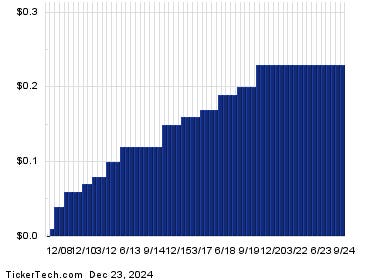Domino’s is a high-quality asset lite business which has delivered solid results historically for shareholders
By Blue Chip Portfolios
Summary
- Domino’s has significantly outperformed the S&P 500 over long-term holdings periods
- The company operates a high-quality asset lite business model which allows it to generate very high returns on invested capital
- Warren Buffett’s Berkshire Hathaway recently initiated a position in the stock
- I view Domino’s shares as reasonable valued at current levels and an attractive investment opportunity
Shares of Domino’s Pizza (DPZ, Financial) have proved an excellent long-term investment historically. Over the past 10 years, Domino’s shares have delivered a total return of roughly 430%. Comparably, the S&P 500 has delivered a total return of roughly 259% over the same time period.
In addition to having a strong long-term history of delivering results for shareholders, Domino’s recently picked up the endorsement of legendary investor Warren Buffet. I do not find Buffett’s decision to invest in the company as surprising given the fact that Domino’s is an easy-to-understand high-quality business trading at a reasonable price.
I believe the stock represents an attractive growth at a reasonable price investment opportunity at current levels.
Company Overview
Domino’s, founded in 1960, is the largest pizza company in the world with more than 21,000 locations across more than 90 countries. While the company’s single largest market is the U.S., its international business is larger accounting for roughly 14,702 locations compared to 6,930 stores in the U.S. The company operates with a franchise model and roughly 99% of locations are owned and operated by independent franchisees.
Domino’s primarily generates revenues by charging royalties to franchisees as well as selling food, equipment, and supplies to franchisees. Franchisees in the U.S. are generally required to pay a royalty of 5.5% on sales while international franchisees pay royalty fees of roughly 3% of sales on average. Revenue from supply chains sales accounts for the largest share of Domino’s total revenue accounting for roughly 63% of total revenue. Key competitors include other large pizza chains such as Pizza Hut, Papa John’s, Little Caesars, and others. The company also competes directly with smaller mom and pop local operators. In the U.S., Domino’s is the market leader and is estimated to have a 40% market share of consumer spend on pizza at quick service restaurants.
High-Quality business with competitive advantages
Domino’s is a high-quality business in that it is able to generate very high returns on invested capital as the company’s franchisee focused business model is not highly capital intensive. As shown by the chart below, Domino’s has been able to generate consistently high levels of returns on invested capital. Moreover, the company’s business is also highly recession resistant in that pizza tends to be one of the cheaper dining options available to consumers and spending on quick service restaurants such as Domino’s tends to benefit from consumers trading down from more expensive restaurants during periods of economic challenges.
Domino’s competitive advantage is driven by the company’s large scale and strong brand. Benefits from scale include better pricing power with suppliers compared to smaller players as well as a larger store base to spread across the costs of R&D, marketing, and advertising initiatives. Moreover, Domino’s large scale also allows its network to benefit from centralized spending on technology. Domino’s brand is highly recognized and often associated with reliability and quality. These factors have allowed Domino’s to deliver consistent earnings growth historically despite the fact that the pizza business is highly competitive.
Buffet backing
Warren Buffett’s Berkshire Hathaway recently disclosed that, as of Q3 2024, it had purchased roughly 1.28 million shares of Domino’s. The position is worth roughly $550 million based on the current share price. While this investment is not one of Buffett’s largest holdings, I would not be surprised to see Buffett increase his stake further from the current levels given the huge amount of cash Berkshire is currently sitting on. Moreover, Berkshire’s stake currently accounts for roughly 3.7% of Domino’s shares outstanding indicating that Berkshire could add significantly to its investment and not become an overly large holder of Domino’s shares which could make it difficult to sell in the future due to liquidity constraints.
While Buffett has not commented publicly on the Domino’s stake, the company has all the traits of a classic Buffett investment in that it is an easy-to-understand business high-quality business. Additionally, Buffett has made a number of investments in the food space historically including Coca Cola, Kraft Heinz, Dairy Queen, See’s Candies, and others.
Domino’s shares initially moved higher by about 10% following the disclose of Berkshire’s investment on November 15 but have more recently given up most of those gains. Domino’s shares are now trading about 4% above where they were prior to the disclosure of Berkshire’s investment. Thus, investors now have the opportunity to invest alongside Buffett without paying a significant premium related to where the stock was trading at prior to the disclosure of his investment.
Valuation is reasonable
Domino’s shares currently trade at roughly 26x consensus FY 2025 earnings per share. Comparably, the S&P 500 trades at roughly 22x consensus forward earnings. While Domino’s is clearly trading at a valuation premium to the broader market, I believe this is warranted given the high-quality recession resilient nature of the company’s business and solid growth prospects.
Over the past 10 and 5 years respectively, Domino’s has grown its earnings per share at a compound annual growth rate of roughly 19% and 12%. Consensus estimates for FY 2025-2027 call for the company to report earnings per share growth of 6%, 10%, and 7% respectively. However, I view these estimates very conservative given the company’s solid historical growth trajectory and significant new store opportunities. In 2025, the company expects to grow its store count by 800 to 850 which represents a roughly 4% store growth rate based on the current store count of roughly 21,000. From 2026 – 2028, the company has said expects to grow sales at an annual growth rate of 7%+ while growing income from operations at a rate of 8%+.
I believe the company’s earnings per share have a potential to grow even faster than operating income due to the impact of share repurchases. During Q3 2024 the company repurchased 443,302 shares for $190 million implying a purchase price $428.6 per share which is modestly below the stock’s current trading level. As of September 8, 2024, the company had an additional $926 million remaining under its share repurchase authorization which amounts to nearly 6% of all shares outstanding based on current market prices. Historically, Domino’s has been a significant repurchaser of its own shares and has reduced its share count by roughly 38% over the past decade. I expect significant repurchase activity to continue going forward as the business does not require significant capital investment to grow given its franchise model.
Domino’s shares also appear reasonably valued compared to quick service restaurant peers. Papa John’s International trades at roughly 19x consensus FY 2025 earnings per share while Yum Brands, owner of Pizza Hut and other chains, trades at roughly 23x consensus FY 2025 earnings per share. While these companies have similar near-term growth prospects to Domino’s, I believe Domino’s premium is justified given its scale advantage in the pizza business.
It is difficult to argue that Domino’s is cheap given its premium valuation to the broader market and peers. However, I do think the valuation is fair. The stock’s guru focus value also suggests the current valuation of the stock is reasonable based on a wide range of metrics.
Leverage is a key risk to consider
Perhaps the biggest risk to consider with Domino’s is its relatively high degree of leverage. As of the end of Q3 2024, the company’s net leverage ratio was 4.9x. While this is an improvement from the 5.5x level during the same period a year ago, it is still a relatively high level of leverage. The vast majority of the company’s debt is in the form of fixed rate notes which carry relatively low coupons as they were issued prior to the 2022 rate hiking cycle. The benefit of this is that the company enjoys a very low weighted average borrowing cost of 3.8%. However, to the extent interest rates stay elevated or rise from current levels the company will eventually need to refinance its existing fixed rate debt at much higher rates which could lead to increased interest expense.
That said, due to the company’s relatively predictable cash flows streams and capital lite business model I believe the company could use cash generated from the business to deleverage over the next few years if rates move materially higher from current levels.
Conclusion
Investing guru Warren Buffett has said:
“It is far better to buy a wonderful business at a fair price than a fair business as a wonderful price.”
I view Domino’s as a wonderful business at a fair price given its high-quality recession resistant business model business model. The company has a long history of delivering solid results for shareholders through organic earnings growth and share repurchases. I expect these trends to continue going forward and view the stock as an attractive investment at current levels.
Read the full article here
















